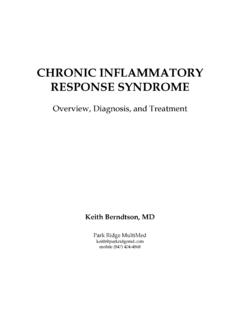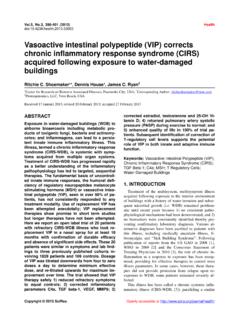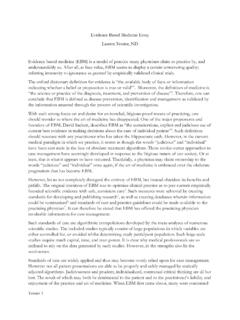Transcription of Understanding Chronic Inflammatory Response Syndrome …
1 1 Components of biochemical stew in WDB: Fungi (mold and its fragments) Bacteria (and its fragments) Volatile Organic Compounds Endotoxins Actinomycetes See Appendix 1 for additional details Understanding Chronic Inflammatory Response Syndrome (CIRS) Definition, Diagnosis, and Treatment By Natasha Thomas, What is CIRS? A Deeper Look at Biotoxins Chronic Inflammatory Response Syndrome (CIRS), also known as biotoxin illness, describes a group of symptoms, lab findings, and targeted test results associated with biotoxin exposure, especially in genetically-susceptible people. Most of what we know about biotoxin illness is the result of practice-based studies done by physician and researcher, Dr.
2 Ritchie Shoemaker. His research dates back to 1997. When practicing family medicine in the rural coastal town of Pocomoke, Maryland, he linked a previously undefined illness to a toxin produced by a fish-killing dinoflagellate known as Pfiesteria. Since then, Dr. Shoemaker has linked this same kind of illness to toxins from water-damaged buildings, as well as toxins associated with tick-born microbes. Over time, Dr. Shoemaker developed a thorough description of this illness and called it Chronic Inflammatory Response Syndrome (CIRS). Through his practice-based research, he also developed methods to diagnose and treat this illness, bringing back health to thousands of patients worldwide.
3 Exposure to Biotoxins Routes of exposure may include: Inhalation in WDB: Occurs when a patient is exposed to biotoxins through breathing while inside a water-damaged building (WDB). WDB can harbor a dangerous mix of various chemicals, mold, bacteria, and inflammagens that together create a biochemical stew, which causes illness. CIRS is not caused by one particular element of this biochemical stew, but rather the combination of these things causing 2 multi-system inflammation. Shoemaker estimates that 80 percent of CIRS cases are caused by repeated exposure to water-damaged buildings. These cases are designated as CIRS-WDB.
4 Tick or Spider Bite: Patients may not always realize they have been bitten by a tick, though the infections ticks carry can include Lyme disease (Borrelia burgdorferi) and Babesiosis (Babesia microti), among others. The bite of the recluse spider species may also cause biotoxin illness. Ingestion: Patients who have eaten reef fish contaminated with dinoflagellate algae (that produces Ciguatera toxin) may develop an illness. Exposure to the Ciguatera toxin occurs when eating reef fish that have eaten smaller fish that consumed the toxin producing dinoflagellate. Direct Contact with Contaminated Water: Patients may be exposed through direct contact with water contaminated by toxins in areas of fish kills such as Pfiesteria and Cyanobacteria, including inhalation of airborne or aerosolized toxins from this source.
5 Most biotoxins have the structural form of ionophore or amphipath. These are extremely small molecules capable of moving from cell to cell through cell membranes without being carried in the bloodstream. This ability of biotoxins to pass through cell membranes with ease means they are difficult or impossible to find in standard blood tests. How do biotoxins get into the body and why doesn t the immune system take care of them? As mentioned, biotoxins can enter the human body through inhalation, ingestion, tick or spider bites, and direct contact with contaminated water sources. The biotoxins can cause acute illness, but for people who are genetically susceptible, they can cause lasting Chronic illness.
6 For many people, biotoxins are recognized by the immune system correctly, broken down, and removed from the body. However, genetically-susceptible people have immune systems that do not recognize the biotoxins and fail to remove them, leaving the biotoxins circulating in the body indefinitely, and causing inflammation throughout the body. 3 Diagnosing CIRS Diagnosing CIRS and biotoxin-related illness can be difficult, if not impossible without Understanding biotoxins and how they cause damage in the body. Figure 1. Actions of biotoxins in the body of a non-genetically-susceptible person Figure 1 (above) shows the way biotoxins impact a person who is not genetically susceptible to developing biotoxin illness.
7 In this situation, the immune system correctly recognizes the biotoxin, leading to antibody production and removal from the body. Figure 2 shows the way biotoxins impact a person who does have genetic susceptibility. The immune system is unable to correctly identify the biotoxin, bind it, and remove it. This allows the biotoxin to recirculate throughout multiple body systems repeatedly, causing damage along the way. In this case, the biotoxin can remain in the body indefinitely. Figure 2. Actions of biotoxins in the body of a genetically-susceptible person Due to the way biotoxins cause illness and the way they move throughout the body and its various systems, more common testing methods like basic blood tests are rarely helpful.
8 What s more, the microbes or irritants that released the biotoxins into the body could already be eliminated from one s system. This is where evidence-based medicine and testing comes in. To look for biotoxins and 4 make a diagnosis in cases of CIRS and biotoxin-related illness, we have to look for the evidence of the damage the biotoxins cause in various body systems, particularly the immune system. In many other types of illness, doctors can test for the pathogen or disease-causing organism itself. In suspected cases of CIRS, the biotoxins transfer from cell to cell through cell membranes so they aren t present in the serum of the blood (that s why standard blood tests are rarely helpful in these cases), and makes finding the damage biotoxins cause the key to the diagnosis.
9 There is a comprehensive set of tests we use to find the evidence we need to determine that biotoxins are involved. However, first we must start with a complete medical history and physical exam. It is essential to document all of the symptoms the patient is experiencing, and medical history along with any history of known exposure to common sources of biotoxin-producing elements. After collecting all of this information, we move onto a comprehensive list of tests. Symptom Cluster Analysis: Understanding CIRS Symptoms While CIRS symptoms may appear random at first, Dr. Shoemaker s statistical analysis revealed that symptoms do have commonalities that allow them to be broken into 13 distinct clusters as shown below.
10 Each block below in Figure 3 lists a unique cluster of symptoms. Figure 3. The 13 unique symptom clusters used in symptom cluster analysis Diarrhea Abdominal pain Numbness Nu Congested sinuses Shortness of breath Impaired memory Difficulty with word finding Heightened skin sensitivity Tingling/Pins and needles Disorientation Metallic taste Watery eyes Weakness Body aches Headache Sensitivity to light Trouble learning new info Blurry vision Night sweats Mood swings Ice-pick pain Red or bloodshot eyes Deep, persistent fatigue Trouble concentrating Dizziness Static shocks Extreme thirst Cough Confusion Joint pain Morning stiffness Muscle cramps Trouble regulating body temperature Frequent urination 5 Neurotoxin Biotoxins that impact nerves and impair neurologic function are also called neurotoxins.










